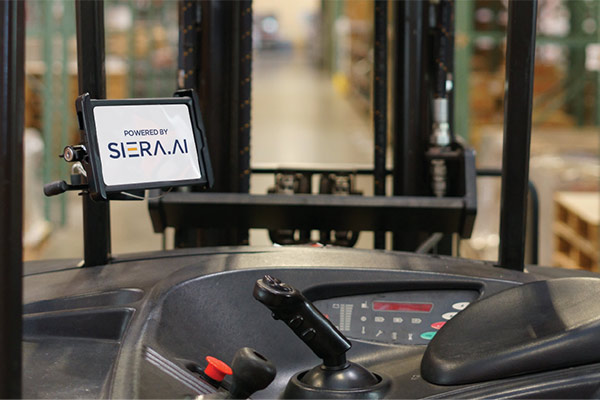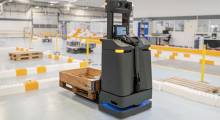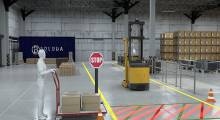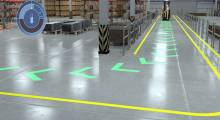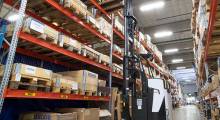Although suppliers showed off numerous robotics offerings during ProMat DX this week, how can warehouse and factory operators be sure to get a return on their investments? Efficiency, safety, and productivity can be measured, and systems are emerging that can add the benefits of automation without requiring an investment in all-new vehicles, claimed SIERA.AI.
The safety hazards around current forklifts are well-documented: 1 in 6 workplace deaths involves a forklift, with 96,000 accidents annually costing North American businesses $35 billion a year. Safety incidents are still largely tracked and reported on paper, said Austin, Texas-based SIERA.AI.
As much as 81% of manufacturers who adopted autonomous mobile robots (AMRs) reported no cost savings, according to consultancy PWC and the Manufacturing Institute.
At the same time, the global forklift market is experiencing a compound annual growth rate of 7.3% between 2020 to 2027 and will reach $81.4 billion, predicts Allied Market Research. In addition, Internet of Things (IoT) systems around lift trucks will also experience a CAGR of 12% between 2020 and 2025, reaching $47.6 billion, forecasts IndustryARC. As deployments grow, the need to guarantee safety and productivity is essential, SIERA.AI said.
SIERA.AI develops autonomy, safety first
As other developers work on fully autonomous lift trucks, SIERA.AI is taking a more incremental approach, applying advanced driver-assistance systems (ADAS). Its S3 product was a finalist for the Best Product Award at ProMat DX, and the company has developed the T-10 robotic tug, which has a 10,000-lb. capacity.
“We started as an automation company focused on AMRs, but as we took that to market, it became clear that one reason why warehouse managers want to automate is safety,” said Saurav Agarwal, founder and CEO of SIERA.AI. “According to PWC's recent report on the state of industrial mobility, 32% of manufacturers want automation because of safety, not just labor shortages. Businesses may not adopt robots if they don't think it's safe or is lacking in autonomy.”
“Our experience when talking with customers, VPs of operations, and EHS [environmental health and safety] managers is that they need both efficiency and safety for productivity,” he told Robotics 24/7. “The same technologies for autonomous driving—computer vision, mapping, digitization—can enable lift truck safety.”
SIERA.AI said it has detected 50 equipment failures per month and prevented 11,000 accidents last year. “Our system builds on AI dashcams, and capturing equipment failures can save money and time instead of it not passing inspection.”
“In the old way, a brand-new forklift might look 10 years old after one month and has caused hundreds of thousands of dollars of damage,” Agarwal said. “You might have 200 forklift operators and three shifts, and turnover means they don't know the equipment or environment.”
“People take a reactive approach to safety—it's human nature—but they're proactive about mandatory compliance,” he said. “A pedestrian injury can cost $500,000 and a death $1 million.”
“Our vision is to make vehicles 10 times better in terms of safety and five times cheaper than current autonomous forklifts,” Agarwal said. “Today's solutions are mostly doing point-to-point materials handling, with well-defined use cases and rigid infrastructure.”
Looking to grow without adding infrastructure
“We're transforming how things are done, by adding proactive depth perception and mapping to human-driven vehicles. The goal is to have an autonomous solution that's infrastructure-free, with cost savings within 12 to 18 months, and at the $50,000 price point of a current forklift truck,” said Agarwal. “We've developed an AMR and are working on autonomous lift trucks, but our ADAS kit costs less than $5,000 and can be added to almost any brand.”
“SIERA.AI's system is the only one that does end-to-end proximity alerts, has machine vision connected to the cloud, and includes near-miss tracking,” he said. “Near misses are underreported, but they're an accurate measure of risk. Our system can automatically slow a vehicle, preventing the driver from making a mistake.”
“Another key differentiator is that we digitize mandatory OSHA [Occupational Safety and Health Administration] processes and can prevent accidents without requiring badges that cost $7 million and are then thrown away,” Agarwal said. “We capture paper-based processes and send data to the cloud via cellular.”
Why does SIERA.AI rely on such connections to the cloud? “Wi-Fi is a pain for any AGV [automated guided vehicle] company, and we wanted our system to be independent of the IT-managed network,” Agarwal replied. “It's a bolt-on, so it requires no complex IT integration, and the system can also work in offline mode. It needs cellular only for sharing collected data for analytics.”
“We've also partnered with a major cellular network and can provide a repeater,” he added. “Like automotive companies, we want 5G to improve safety and autonomy, but it's not there yet in the U.S. Carriers are investing in the big cities, but not in rural areas where many distribution centers are. Some companies themselves are looking to invest in small cells like those Qualcomm makes.”
Markets and plans
How has the market responded to SIERA.AI's AMRs and ADAS applied to lift trucks?
“The demand in e-commerce means that 50% of the labor force churns every six weeks,” Agarwal said. “Logistics vehicle demand is at 2030 levels with infrastructure that's at 2010 levels—that's why injuries are increasing, and COVID-19 as increased pressure for worker safety.”
“There are a lot of players in this market, but it's a fragmented industry, including telematics,” he noted. “In automotive and trucking, autonomy is huge, but in offroad or industrial mobility, it's just starting to grow.”
“Since we came out of stealth, our revenue has more than doubled quarter over quarter,” added Agarwal. “Our team has grown to 20 people, and we expect it to double again in the next 12 to 18 months. We're growing the engineering team and adding to our customer support and success teams.”
“SIERA.AI also works in meat packing, food production, and fashion,” he said. “We've just added this quarter mining, metals, and Tier 1 automotive suppliers.”
SIERA.AI is looking for later-stage investment, he said. “Our goal is to work with investors who understand the logistics space and have interest in our long-term vision—freeing humans of the 'three Ds'—dull, dirty, or dangerous work,” Agarwal said. “We're taking a more pragmatic approach to what the vehicle makers learned: The path to autonomy is through safety.”
About the Author
Follow Robotics 24/7 on Linkedin
Article topics
Email Sign Up

